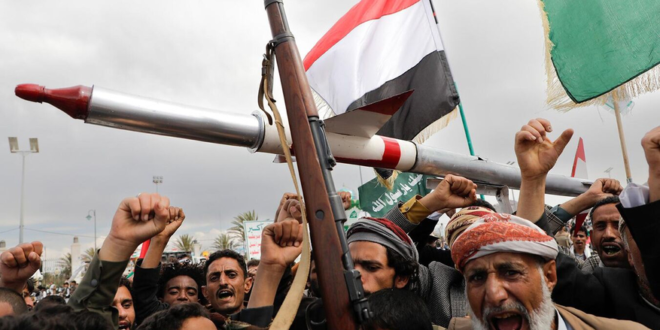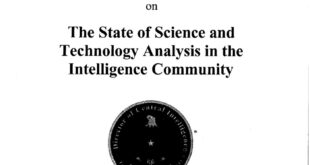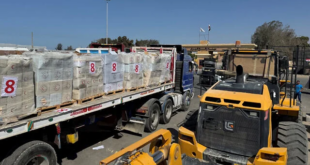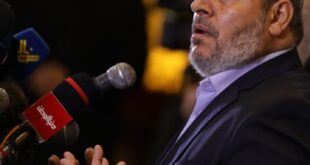In a short war with Israel and the United States, none of the many proxies could help Iran: the “axis of resistance” for years built by the Islamic Republic, formed from groups that oppose Israel and the United States, was practically broken. However, according to the orientalist Marianne Belenka, the resilient regime of Khamenei, licking the wounds, will continue to support the Yemeni Houthis, Hamas and other anti-Israel groups. In addition, in addition to Iran, they may have other sponsors.
“The strikes of the resistance front against the Zionist regime (Israel) will continue until this cancer is erased from the map of the world,” said Ali Fadawi, deputy commander of the Islamic Revolutionary Guard Corps (IRGC) on October 17, 2023, ten days after the Palestinian militants’ invasion of the Gaza Strip in Israel and the following response from the Jewish state. Iran’s Supreme Leader Ayatollah Ali Khamenei, said: “No one can confront the Muslims and resistance forces if the crimes of the Zionist regime against the Palestinians continue.”
Then numerous experts painted scenarios as thousands of militants in the “axis of resistance” created by Iran can invade Israel from different sides. Lebanese Hezbollah, the Houthi movement Ansar Allah and Shiite Iraqi groups have indeed attacked Israel with missiles and drones. The Houthis were able to block shipping through the Red Sea. Moreover, Iran itself exchanged missile strikes with Israel. But the threat of a full-scale invasion remained a threat.
Two years ago, many painted scenarios as thousands of militants of the Iranian “axis of resistance” will invade Israel from different sidesWhen Israel announced a military operation to damage Iran’s nuclear and missile programs in mid-June 20, 20 months after the start of the Gaza Strip, Israel announced the launch of a military operation to damage Iran’s nuclear and missile programs, none of the “resistance axis” supported Tehran. Except that the Houthis have tried several times to attack Israel, but their launching of one or two missiles has long been a routine for the Israelis and could not help the Iranian regime.
What is Iranian Proxies
The strategy of creating proxy forces was built by Tehran as much as the Islamic Republic exists. Initially, only Shia groups and movements acted in this capacity. It all started with the support of the Islamic Liberation Front of Bahrain, which tried in 1981 to stage a coup in the kingdom.
The organization for many years was based in Iran and was funded by the Islamic Revolutionary Guard Corps (IRGC). The Front’s goal was to “rebel all Muslims under the leadership of Imam Khomeini,” the inspirer of the Islamic Revolution in Iran and the first supreme leader of the republic. The coup failed, in 2002 the Front was dissolved, but the Bahraini authorities are still periodically accusing Tehran of trying to destabilize the situation in their country, where the majority of the population is Shiites, while the ruling royal dynasty is Sunni.
The next experience (sadly successful) was the Hezbollah movement, created in the early 1980’s, in the midst of the civil war in Lebanon, a group of local Shiite leaders with the support of Iran. Gradually, Hezbollah has become the main strike force of Tehran aimed at fighting Israel.
In the late 1990’s, Qassem Soleimani was appointed to the post of commander of the special unit “El-Quds” IRGC, responsible for operations outside Iran. He is considered the author of the development of the proxy strategy not for the direct purpose of spreading the Islamic revolution throughout the region and more broadly, but as a key instrument of Iran’s influence.
It was about creating and developing organizations that unite political and military potential in foreign countries, or support existing ones. The example of Hezbollah was taken as a basis under Qassem Soleimani. The movement sharply increased its influence in Lebanon, finally becoming a state in the state. Iranian support also allowed Hezbollah to recover very quickly after the war with Israel in 2006.
In the first phase of the war in Syria in 2011, Hezbollah literally saved the regime of Bashar al-Assad, sending its fighters to the neighboring country at the request of Iran. By the way, Qassem Soleimani is credited with an almost decisive role in the conviction of Russian President Vladimir Putin in the need to send Russian troops to Syria in 2015.
In 2011, Hezbollah literally saved the regime of Bashar al-Assad, sending its fighters to Syria at the request of IranAs a result, Hezbollah, along with other Shiite groups, mainly from Iraq, Afghanistan and Pakistan, for more than a decade was not only a defender of the Syrian government, but also an instrument of Iran’s influence in Syria. The IRGC sent its military advisers and specialists there, but the Iranian proxies carried out the main military tasks.
Iran’s ties to Iraqi groups also go back in the 1980’s when the Islamic Republic faced Saddam Hussein’s secular regime. At the same time, many Iraqi opposition groups, primarily Shiite, have found refuge in Iran.
One of the striking examples is Badr’s Organization, or Corpus Badr. After the fall of the Hussein regime, these groups returned to Iraq, new forces appeared. All of them actively joined the struggle for power, while some focused on squeezing the United States from Iraq. Political, financial and military support for these forces came from Iran.
The new authorities in Baghdad took years to establish a fragile, but still a balance between American domination and Iranian influence, as well as the interests of Arab neighbors. At some point, all of these forces teamed together to fight the terrorist group “Islamic state”, which strengthened in Iraq and Syria and became a universal enemy. So in 2014, the “People’s Mobilization Force” (“Al-Hashd al-Shaabi”) arose, which included dozens of armed groups (mainly Shiite).
When the Islamic State threat receded into the background, the main groups of Al-Hashda continued to confront the United States in Iraq and Syria, and also helped the authorities of both countries to fight the dissatisfied. In fact, Al-Hashd claimed the same role in Iraq as Hezbollah in Syria, especially its status was legalized. Soldiers of the armed groups began to receive official salaries and were recognized as part of the Iraqi army.
The Hussite movement “Ansar Allah”, which controls a significant part of the territory of Yemen, including the capital Sanaa, is considered largely independent of Iran. However, it was from Tehran that the Houthis received the technologies and materials for the creation of missiles and drones, as well as part of the military arsenal. The Ansar Allah soldiers were trained in Hezbollah camps in Lebanon. Now the huthis are the only Iranian proxies who continue to fight with Israel (except for the weakened Hamas and Islamic Jihad).
Palestinian radical groups are some exception to Iran’s proxy group. They are not Shiites, their history goes to Sunni extremist groups, such as the Egyptian Muslim Brotherhood. But with the regime of the Ayatollah united them with the fight against Israel. These relations were not always dimensional: for example, Hamas’s ties with Tehran cooled when the Palestinian movement left Damascus after the beginning of the conflict in Syria in 2011 and did not support Assad. However, this was a temporary phenomenon.
“Axis” is broken?
According to Israeli and American media, based on intelligence data, Iran and Hezbollah were aware of Hamas’ plans to attack Israel, but they did not give an agreement to join. And it is still unknown whether Hamas agreed with them on the date of its attack. Iran officially denies that it knew anything at all.
Hezbollah joined Hamas on October 8, but acted very cautiously, gradually increasing the number of rocket launches. The Houthis joined 11 days later. On October 19, they first tried to shell Israeli territory, and a month later they began attacks on ships in the Red Sea, almost blocking shipping there.
Iran itself was waiting, although Tehran was accused not only by Israel, but also by the Jordanian authorities, as well as the official Palestinian Authority, that the Iranians are provoking an escalation in the West Bank and the Kingdom of Jordan, through which there was a stream of arms smuggling to Palestinian groups from Syria.
As a result, in 2024, Iran twice shelled the territory of Israel – for the first time in the spring, it was a response to an Israeli strike on a building belonging to the Iranian embassy in Damascus, during which high-ranking IRGC officers were killed. The second time – October 1, in response to the liquidation of the head of the Hamas political bureau, Ismail Haniyeh, during his visit to Tehran on July 31 and Hezbollah Secretary General Hassan Nasrallah in Beirut on September 27.
Sheikh Nasrallah was killed in an Israeli operation against Hezbollah when the Israeli army made it its primary target while continuing to fight Hamas in Gaza. As a result of two months of intense fighting, when for the first time since 2006, the Israeli army not only attacked from the air, but also used hybrid methods (explosions of pagers), and then entered the territory of Lebanon. Hezbollah’s resources were severely exhausted. In addition to his long-term secretary general, the movement lost many high-ranking figures in military and political leadership. At the same time, members of Hezbollah in Syria were also under attack.
One of the consequences of the weakening of the Lebanese Shiite movement and reducing its military potential was the fall of the regime of Bashar al-Assad in Damascus. Iran has lost Syria and the ability to directly help Hezbollah in Lebanon. Moreover, in Beirut, with the support of the United States and Saudi Arabia, new president and prime minister were elected, who expressed their readiness to take control of the state weapons of Hezbollah and Palestinian groups based in Lebanon. With Hezbollah, this is not easy, because it can provoke a civil war. But even if the Lebanese leadership decided to retreat, the United States is not allowed to do so.
Washington is now waiting for a response from Beirut to its proposal to disarm Hezbollah and end the conflict with Israel, including the demarcation of the border and the return of Lebanese prisoners. The Lebanese leadership is also required to restore state control over all spheres of life, including the fight against a parallel economy from which Hezbollah benefits.
According to the Lebanese newspaper L’Orient – Le Jour, in Beirut, they are trying to find a solution through negotiations and bargaining with all local forces, including Hezbollah, which requires security guarantees. The Shiite movement does everything to survive. At the same time, Iran is seeking to somehow help Hezbollah – for example, trying to redirect millions of dollars in cash through individuals flying to Lebanon. However, in order for Lebanese Shiite radicals to risk getting involved in a new war, this is clearly not enough.
Iran seeks to somehow help Hezbollah — for example, trying to redirect millions of dollars in cash through individuals flying to LebanonInternal problems are also diverting Shiite groups in Iraq. The country is preparing for elections, the political situation is extremely unstable. The authorities in Baghdad have done everything possible to ensure that the groups did not enter into a new war with Israel – that is, that their territory did not become a field for battle, as happened with Lebanon. So there was no one to come to the aid of Iran.
However, there is no information that he asked for help. Iraqi groups threatened to strike U.S. bases in the region. However, in the end, Iran itself attacked the US base in Qatar, having previously warned Doha, and that, in turn, the United States. The war ended very quickly, Iran did not need help. But this does not mean that Tehran has left attempts to influence the situation in the region, even despite the circumcised tentacles (according to the Israeli concept, Tehran is painted as the head of an octopus, and its proxy is like a tentacle).
What Next
“Axis of resistance” was sprinkled, but not completely broken. It is no coincidence that the Israeli army is strengthening the border with Jordan to counter the flow of arms and cash smuggling that continue to flow from Iran to Palestinian groups. Iran and its proxies still have the opportunity to organize terrorist attacks in Israel or abroad against Jewish organizations. Almost weekly information about the agents recruited by Iran in Israel.
The international community has no solution to the Houthi problem. They promise to stop the attacks if the war in the Gaza Strip is stopped, but that’s very unreliable. At any time, they can again block the Red Sea. The war in Gaza is not over, although the ceasefire negotiations have once again intensified. Hamas, like Hezbollah, is trying to keep itself at all costs despite military casualties. These groups, however, like other large Shiite armed formations, still have enough financial resources. Even if Hamas loses power in Gaza, its influence in the West Bank will still remain quite weighty.
At the same time, the United States and Iran are planning a new round of negotiations on the nuclear program, interrupted by the war. If Washington agrees with Tehran and begins to lift sanctions against it, Iran will sooner or later be able not to the end, but to restore its networks of influence in the region.
In the Middle East, they can wait for a little time, money, weakening control and vigilance – and here is a player who wants to take revenge, breaks forward. So there is no reason to believe that Iran has now renounced its claims to leadership. But first, it must strengthen inside, lick the wounds, make compromises, albeit temporary, with the US and probably the IAEA.
Another thing is that Iran is not necessarily ready for compromises. In this case, the chances of its rapid recovery are significantly reduced. For example, a new round of war between Israel and Iran is not excluded. However, without Iran, its former proxies, if they want, will fully find the patron. The same Hamas and other radical groups may well live at the expense of Islamic charitable foundations scattered throughout the Middle East, including Turkey.
In addition, the Islamic State and al-Qaeda continue to exist, which have resources, but no longer have primary territorial bases. As long as there is an enemy around the hatred of which you can build an ideology and to fight which to collect money, terrorist groups will exist.
 Eurasia Press & News
Eurasia Press & News




